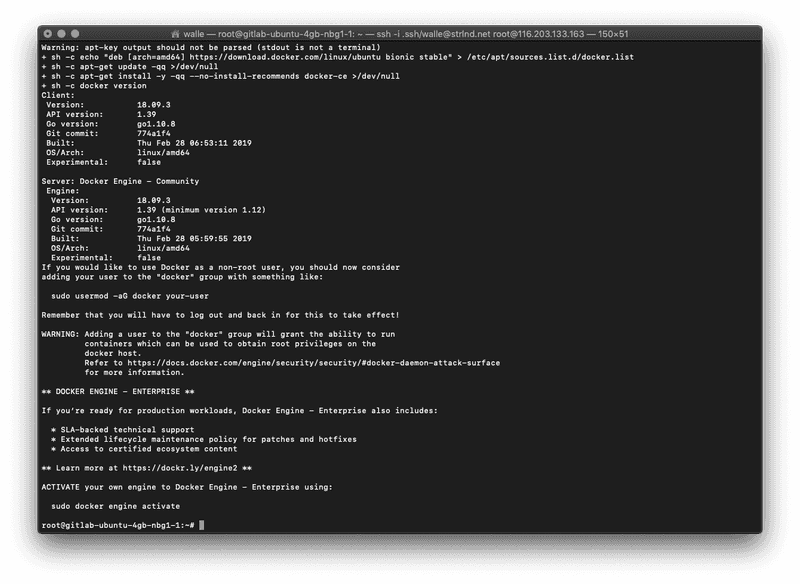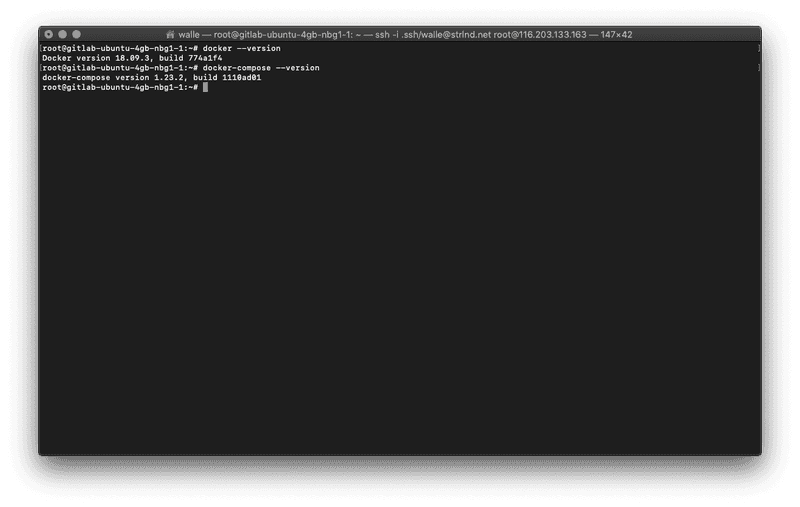Introduction
In this tutorial, I will show you how to set up a GitLab CE server on a Hetzner Cloud server using docker and docker-compose. As reverse proxy and to provide a LetsEncrypt certificate we use Traefik. Also, we provide a docker image registry with GitLab.
Prerequisites
- A Hetzner Cloud machine (I recommend at least the CX23 instance).
- A domain under which we later reach our GitLab server and the docker image registry.
- Ubuntu 18.04 as the operating system.
Step 1 - Install docker and docker-compose
Before we start, we update the system:
apt update && apt upgrade -yNow we install docker and docker-compose. For docker, there is a handy install script at get.docker.com.
First, we download the script using curl:
curl -fsSL https://get.docker.com -o get-docker.shWe then execute it:
sh get-docker.shThe installation should look like this:
Now we have to install docker-compose, for this we simply download the binary:
curl -L "https://github.com/docker/compose/releases/download/1.23.2/docker-compose-$(uname -s)-$(uname -m)" -o /usr/local/bin/docker-composeMake it executable:
chmod +x /usr/local/bin/docker-composeNow we can check that everything is installed correctly:
docker --version
docker-compose --versionIt should look something like this:
If it does then we are done with the prepatory work, and we can proceed with the next step.
Step 2 - Create a docker-compose file
To make it easier for us to manage GitLab and updates later on, we use docker-compose to run our docker containers.
For this we now create our docker-compose.yaml file:
mkdir gitlab
touch gitlab/docker-compose.yaml
vim gitlab/docker-compose.yamlYou can also use
nanoor any other text editor, but I prefervim.
In our case we use local docker volumes to persist our data. For this we use the root path /srv/docker/volumes/. Of course you can change this path as well as most other settings.
Now we add / edit the following content:
version: '3'
services:
gitlab:
image: 'gitlab/gitlab-ce:latest'
container_name: gitlab
restart: unless-stopped
hostname: 'gitlab.example.com' # Change host here
environment:
GITLAB_OMNIBUS_CONFIG: |
external_url 'https://gitlab.example.com' # Change url here
nginx['listen_port'] = 80
nginx['listen_https'] = false
nginx['proxy_set_headers'] = {
"X-Forwarded-Proto" => "https",
"X-Forwarded-Ssl" => "on"
}
# DATABASE CONNECTION SETTINGS: in our case we use postgresql as database
gitlab_rails['db_adapter'] = "postgresql"
gitlab_rails['db_database'] = "gitlab"
gitlab_rails['db_username'] = "postgres"
gitlab_rails['db_password'] = "CHANGE_TO_RANDOM_PASSWORD" # set the database password here
gitlab_rails['db_host'] = "gitlab_database"
# GITLAB DOCKER IMAGE REGISTRY: so that we can use our docker image registry with gitlab
registry['enable'] = false # we do not activate this option because we provide our own registry
gitlab_rails['registry_enabled'] = true
gitlab_rails['registry_host'] = "registry.gitlab.example.com" # Change registry host here
gitlab_rails['registry_api_url'] = "https://registry.gitlab.example.com" # Change registry url here
gitlab_rails['registry_issuer'] = "gitlab-issuer"
# SMTP SETTINGS: So that gitlab can send emails. In our case we send via google mail.
gitlab_rails['smtp_enable'] = true
gitlab_rails['smtp_address'] = "smtp.gmail.com"
gitlab_rails['smtp_port'] = 587
gitlab_rails['smtp_user_name'] = "gitlab@example.com"
gitlab_rails['smtp_password'] = "xxxx"
gitlab_rails['smtp_domain'] = "smtp.gmail.com"
gitlab_rails['smtp_authentication'] = "login"
gitlab_rails['smtp_enable_starttls_auto'] = true
gitlab_rails['smtp_tls'] = false
gitlab_rails['smtp_openssl_verify_mode'] = "peer"
ports:
- "2222:22"
networks:
- traefik_gitlab_net
- gitlab_net
volumes:
- /srv/docker/volumes/gitlab/config:/etc/gitlab
- /srv/docker/volumes/gitlab/logs:/var/log/gitlab
- /srv/docker/volumes/gitlab/data:/var/opt/gitlab
- /srv/docker/volumes/registry/certs:/certs
labels:
- "traefik.enable=true"
- "traefik.gitlab.port=80"
- "traefik.gitlab.backend=gitlab"
- "traefik.gitlab.frontend.rule=Host:gitlab.example.com" # Change host here
- "traefik.gitlab.frontend.entryPoints=http,https"
- "traefik.docker.network=gitlab_traefik_gitlab_net"
registry:
restart: unless-stopped
image: registry:2.7
container_name: gitlab_registry
volumes:
- /srv/docker/volumes/registry/data:/registry
- /srv/docker/volumes/registry/certs:/certs
labels:
- "traefik.enable=true"
- "traefik.frontend.rule=Host:registry.gitlab.example.com" # Change registry host here
- "traefik.port=5000"
- "traefik.backend=gitlab-registry"
- "traefik.frontend.entryPoints=http,https"
networks:
- traefik_gitlab_net
environment:
REGISTRY_LOG_LEVEL: debug
REGISTRY_STORAGE_FILESYSTEM_ROOTDIRECTORY: /registry
REGISTRY_AUTH_TOKEN_REALM: https://gitlab.example.com/jwt/auth # Change url here
REGISTRY_AUTH_TOKEN_SERVICE: container_registry
REGISTRY_AUTH_TOKEN_ISSUER: gitlab-issuer
REGISTRY_AUTH_TOKEN_ROOTCERTBUNDLE: /certs/gitlab-registry.crt
REGISTRY_STORAGE_DELETE_ENABLED: 'true'
database:
image: postgres:10-alpine
container_name: gitlab_database
restart: unless-stopped
networks:
- gitlab_net
environment:
POSTGRES_PASSWORD: "SAME_PASSWORD_AS_ABOVE" # use the same password as the one you used above
POSTGRES_DB: gitlab
volumes:
- /srv/docker/volumes/gitlab/database:/var/lib/postgresql/data
traefik:
container_name: gitlab_traefik
restart: unless-stopped
image: traefik:v1.7
command:
--configFile=/var/traefik/traefik.toml
ports:
- "443:443"
- "80:80"
- "8090:8090"
networks:
- traefik_gitlab_net
volumes:
- /var/run/docker.sock:/var/run/docker.sock
- ./traefik.toml:/var/traefik/traefik.toml:ro
- /srv/docker/volumes/traefik/log:/log
networks:
traefik_gitlab_net:
gitlab_net:All processed? That's it, and we can move on to the next step.
Step 3 - Configure Traefik
Since we use traefik as a reverse proxy, we have to create a configuration file for it. All other settings for traefik are defined in docker-compose.yaml
vim gitlab/traefik.tomlNow we add the following content:
defaultEntryPoints = ["http", "https"]
[entryPoints]
[entryPoints.http]
address = ":80"
[entryPoints.http.redirect]
entryPoint = "https"
[entryPoints.https]
address = ":443"
[entryPoints.https.tls]
[acme]
email = "acme@example.com" # please change this to the email address you want to use to apply for letsencrypt certificates.
storage = "acme.json"
entryPoint = "https"
OnHostRule = true
acmeLogging = true
[acme.httpChallenge]
entryPoint = "http"
## if you want you can activate access to the traefik dashbord here. You can then access the dashboard at http://gitlab.example.com:8090
#[web]
#address = ":8090"
#[web.auth.basic]
#users = ["user:encryped_password"]
[docker]
endpoint = "unix:///var/run/docker.sock"
watch = true
exposedbydefault = falseDon't forget to make DNS entries for your domain. Otherwise, the certificate can't be issued in the next step (we use HTTP validation).
Step 4 - Start the server
There's not much left. If the DNS entries point to our server, we can now continue with the following points.
First we switch to our gitlab directory, if we are not already there:
cd gitlabLet's download all the docker images we need:
docker-compose pullStart everything:
docker-compose up -dIf we configured everything correctly, the GitLab server, the database, the docker registry, and our reverse proxy should start now.
GitLab itself needs some time for the bootstrap process. We can check the status with docker ps
(health: starting) should switch to (healthy)
Don't worry if the registry container is hanging in a restart loop; we'll get to that in Step 5.
When everything is ready, we should reach GitLab on gitlab.example.com. Now we can go to the next step.
Step 5: Prepare the registry
For GitLab and our Docker Image Registry to communicate with each other, we need a shared certificate. The good thing is, GitLab creates a key for us at bootstrap, only the registry doesn't know about it yet.
What we have to do is copy the certificate key created by GitLab into the volume of the registry and create a certificate out of it. Let's do it:
cd /srv/docker/volumes/registry/certs/
docker cp gitlab:/var/opt/gitlab/gitlab-rails/etc/gitlab-registry.key .
openssl req -key gitlab-registry.key -new -subj "/CN=gitlab-issuer" -x509 -days 365 -out gitlab-registry.crtAfter a minute the docker image registry should now be available, and we can use it with GitLab.
Conclusion
We can now reach GitLab at gitlab.example.com. At the beginning we are asked to assign a password, the default user is root. I recommend to create a new user and deactivate root after the first login.
Now have fun with your GitLab server!
Appendix: Updating GitLab
Since we use the image tag :latest in our docker-compose.yaml file for GitLab, we only have to perform the following steps for an update:
cd /gitlab
docker-compose pull # download the current image from the docker hub image registry
docker-compose up -d # replaces the containers with a new image.GitLab needs a little time to start again; then you should be working on the latest version.


